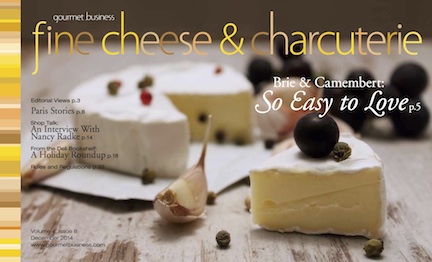
Brie is a Holiday Classic
Here we are in the midst of the holiday season, and I am already planning my cheese platter for Christmas Eve, which is always the highlight for my guests and family. If I didn’t include some variety of Brie in it, I would be met with many disappointed faces. I usually position myself in close proximity to the cheese platter so I can confront the “diggers” who try and avoid the white rind, and only dig out the creamy center. I feel it is my responsibility as the local cheese ambassador to explain why this practice should be discouraged, and also to encourage sampling of the other offerings.
Brie is the perfect entry-level cheese. It’s the cheese that brings them to the platter, and draws them into our world to discover more flavors. If you like butter, you have to like Brie; and who doesn’t like butter? From a merchandising perspective, it’s the perfect lead-in, and that is why we decided to make it one of the central topics of this issue along with other holiday treats. The interesting thing about Brie, I find, is that there are so many variations, each having different consistencies, and a range of flavors from mild to cheeses with distinct flavor profiles, like its cousin, Camembert.
We are treated to an interesting variety of bloomy-rind, soft-ripened cheeses in the USA, but it’s only a fraction of the range of these types of cheeses found in Europe. When James went to an upscale grocery store in Paris while we were attending SIAL, he was amazed at the assortment of cheese he could choose from. Unfortunately, so many of them can’t be imported into the USA due to our strict FDA regulations. As one cheesemaker put it, the inspections require such a minimal threshold of bacteria that it’s near impossible to make some varieties of cheese that meet the standards. And since bacteria levels can rise so quickly once the cheese leaves refrigeration, that even if the bacteria levels met the standard upon cutting the cheese, by the time it is actually tested, the bacteria has risen above the standards. We all understand the importance of food safety, but I am left wondering if more realistic standards should be considered for dairy products. One has to ask if Europeans have been eating these cheeses for centuries without any adverse health effects, then what are we protecting Americans from? Perhaps, we need to form a European cheese lobby to set the government straight!
In the meantime, on behalf of Fine Cheese & Charcuterie and the Gourmet Business family of magazines, we would like to wish you a prosperous holiday season, and we look forward to bringing you more interesting news next year.
David Spencer
Publisher, Gourmet Business
President, HousewaresDirect, Inc.
dspencer@gourmetbusiness.com


